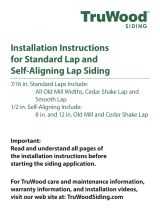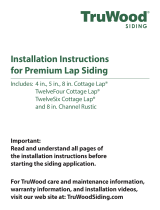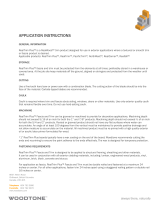
HS1254-P1/4 8/13
REQUISITOS GENERALES
• El revestimiento solapado HardiePlank® puede instalarse sobre madera empresillada o montantes de acero separados un máximo de 24" o.c. o directamente a un
recubrimiento de un mínimo de 7/16" OSB. Las irregularidades en el armazón y el recubrimiento pueden notarse en la aplicación acabada.
• El revestimiento solapado HardiePlank® también puede instalarse sobre aislamiento/recubrimiento de espuma de hasta una pulgada de grosor. Cuando utilice
aislamiento/recubrimiento de espuma, evite clavar demasiado los clavos (sujetadores), porque se podrían producir hundimientos en el revestimiento debido a la naturaleza
comprimible del aislamiento/recubrimiento en espuma. Tenga especial cuidado si utiliza clavos (sujetadores) con clavadoras eléctricas para unir el revestimiento sobre
aislamiento/recubrimiento en espuma.
• Se necesita una barrera resistente al agua de acuerdo con los requisitos del código de construcción local. La barrera resistente al agua debe estar instalada adecuadamente
con protección de penetración y juntas de acuerdo con los requisitos del código de construcción local. James Hardie no asumirá ninguna responsabilidad por la infiltración de
agua. James Hardie fabrica HardieWrap® Weather Barrier, una membrana de drenaje1 no tejida y no perforada que cumple con los requisitos del código de construcción.
• Cuando se instalen productos James Hardie, deben seguirse todos los detalles de espacio que se detallan en las ilustraciones 3-14.
• El grado de acabado adyacente debe inclinarse fuera del edificio de acuerdo con los códigos de construcción
locales, normalmente un mínimo de 6" en los primeros 10'.
• No utilice revestimiento solapado HardiePlank en impostas o molduras.
• No instale productos James Hardie de forma que estén en contacto directo con el agua.
• El revestimiento HardiePlank puede ser instalado en muros planos verticales solamente.
• Para los proyectos grandes, incluyendo proyectos comerciales y multi-familiares, en donde la extensión
longitudinal de la pared es significativa, el diseñador y/o arquitecto debe considerar el coeficiente de
expansión térmica y el movimiento de humedad del producto al momento de diseñar. Puede encontrar
estos valores en el boletín técnico "Expansion Characteristics of James Hardie® Siding Products" en
www.JamesHardie.com.
• NO utilice tintes, pinturas a base de aceite, resina alquídica o polvos recubridores en los productos
James Hardie
®
.
ADVERTENCIA: EVITE RESPIRAR POLVO DE SÍLICE
Los productos James Hardie® contienen sílice cristalino respirable, y en el Estado de California es un material conocido por causar cáncer, y el IARC y NIOSH consideran que es causa de cáncer para las personas
que ocupan ciertos puestos. Respirar cantidades excesivas de polvo de sílice respirable puede causar además la enfermedad de los pulmones discapacitante y potencialmente mortal llamada silicosis, y se ha
relacionado con otras enfermedades. Algunos estudios sugieren que fumar puede aumentar estos riesgos. Durante la instalación y manejo: (1) trabaje en zonas exteriores con buena ventilación; (2) utilice cizallas
de fibra de cemento para cortar o, si no es posible, utilice una hoja de corte HardieBlade y una sierra circular reductora de polvo con un aspirador HEPA; (3) avise a otras personas en las zonas inmediatas; (4) lleve
una máscara para el polvo o respirados adecuada, aprobada por NIOSH (por ejemplo N-95), de acuerdo con las regulaciones gubernamentales aplicables y las instrucciones del fabricante para limitar más la
exposición al sílice respirable. Durante la limpieza, utilice aspiradores con filtro HEPA o métodos de limpieza en mojado; nunca barra en seco. Para obtener más información, consulte nuestras instrucciones de
instalación y la Hoja de datos de seguridad del material, disponibles en www.jameshardie.com o llame al 1-800-9HARDIE (1-800-942-7343). NO RESPETAR ESTOS AVISOS, DIRECTRICES E INSTRUCCIONES DE
INSTALACIÓN PUEDE RESULTAR EN SERIOS DAÑOS PERSONALES E INCLUSO LA MUERTE.
SD050905
REQUISITOS DE INSTALACIÓN - PRODUCTOS CON PRIMER Y COLORPLUS®
Visite www.jameshardie.com para obtener la versión más reciente.
Tablas de Revestimiento Solapado
EN VIGOR DESDE SEPTIEMBRE 2013
EXTERIOR
1. Posicione la estación de corte de forma que el viento no haga que el
polvo vaya al usuario y a otros en el área de trabajo.
2. Utilice uno de los siguientes métodos:
a. Ideal: i. Herramienta de corte
ii. Cizalla (manual, eléctrica o neumática)
b. Mejor: i. Sierra circular reductora de polvo equipada con una
hoja de corte y aspirador con filtro HEPA
c. Bueno: i. Sierra circular reductora de polvo con hoja de corte
(solo debe usarse para corte bajo a moderado)
INTERIOR
1. Corte usando sólo una herramienta de corte o cizalla (manual, eléctrica o
neumática).
2. Posiciones la estación de corte en una zona bien ventilada.
- NUNCA utilice una sierra mecánica en interiores
- NUNCA utilice una hoja de sierra circular que no lleve la marca HardieBlade en
la hoja de corte. - NUNCA barra en seco - utilice supresión húmeda o aspirador HEPA
Nota importante: Para una máxima protección (la menor producción de polvo respirable), James Hardie recomienda usar siempre los métodos de corte "Mejores"
siempre que sea posible.
Los respiradores aprobados NOSH pueden usarse junto con las prácticas de corte descritas para reducir aún más la exposición al polvo. Puede encontrar
información adicional sobre la exposición al polvo en www.jameshardie.com, para ayudarle a determinar el método de corte más apropiado para los requisitos de
su trabajo. Si está preocupado sobre los niveles de exposición o no cumple con las prácticas anteriores, debería consultar con un higienista industrial cualificado
o contactar con James Hardie para obtener más información. SD083105
INSTRUCCIONES DE CORTE
ALMACENAMIENTO Y MANEJO:
SELECT CEDARMILL
©
• SMOOTH • CUSTOM COLONIAL
™
SMOOTH • CUSTOM COLONIAL
™
ROUGHSAWN
CUSTOM BEADED CEDARMILL
©
• CUSTOM BEADED SMOOTH • STRAIGHT-EDGE SHINGLE PLANK
Instale un listón de inicio de
1 1/4" para asegurar
que el ángulo del tablero sea consistente
24" o.c. máx.
barrera resistente
al agua
recubrimiento de
madera contrachapada u OSB
apuntalamiento
sujetador
barrera resistente al agua
Figure 1
Construcción
de doble muro
Construcción
de muro simple
Figure 2
Instale los tableros en contacto
moderado en las juntas de tope
Montante
Clavo a 3/8" del
borde del tablero
barrera
resistente
al agua
protección
de juntas
HardieZone
™
HardiePlank
®
siding
Línea de
clavos (si la
línea no está
presente,
coloque el
sujetador entre
3/4" y 1" del
tablero
superior)
Almacene en plano, en un lugar seco y
cubierto antes de la instalación. Instalar
revestimiento que está mojado o saturado
puede provocar que las juntas de tope
encojan. Transporte los tableros por los
bordes. Proteja los bordes y esquinas de
roturas. James Hardie no se hace
responsable de los daños causados por
un almacenamiento o manipulación
inapropiados del producto.
IMPORTANTE: EL PRODUCTO DEBE INSTALARSE Y ACABARSE DE ACUERDO CON LOS CÓDIGOS DE CONSTRUCCIÓN APLICABLES Y LAS INSTRUCCIONES DE APLICACIÓN
DE JAMES HARDIE, DE LO CONTRARIO, PUEDEN PRODUCIRSE DAÑOS PERSONALES, EL RENDIMIENTO DEL SISTEMA PUEDE VERSE AFECTADO, SE PUEDEN INFRINGIR LOS
CÓDIGOS DE CONSTRUCCIÓN LOCALES Y ANULAR LA GARANTÍA DEL PRODUCTO. ANTES DE LA INSTALACIÓN, CONFIRME QUE ESTÁ USANDO LAS INSTRUCCIONES
CORRECTAS DEL PRODUCTO HARDIEZONE
™
. LA INSTALACIÓN DE LOS PRODUCTOS HZ10
®
FUERA DE UNA UBICACIÓN HZ10
®
ANULARÁN SU GARANTÍA. PARA
DETERMINAR QUÉ HARDIEZONE™ SE APLICA A SU UBICACIÓN, VISITE WWW.HARDIEZONE.COM O LLAME AL 1-866-942-7343 (866 9HARDIE)
INSTALACIÓN:
TRATAMIENTO DE JUNTAS
El código requiere una o más de las siguientes
opciones para el tratamiento de juntas (de
acuerdo a lo referenciado en 2009 IRC
R703.32).
A. Protección de la junta (recomendada por
James Hardie)
B. Calafateado* (el calafateado no se
recomienda para ColorPlus por razones
estéticas,
ya que el calafateado y el ColorPlus
se van a desgastar de modo diferente.
Por esa misma razón, no hay que calafatear
cabezas de clavos en productos ColorPlus).
C. Cubiertas de juntas "H").
Nota: Pintar sobre la masilla puede producir un tono diferente en comparación a la pintura PrimePlus. *Consulte la sección de calafateo en estas instrucciones.
1
Para obtener información adicional sobre HardieWrap
®
Weather Barrier, consulte con James Hardie en el 1-866-4Hardie o en www.hardiewrap.com.
deje un espacio apropiado
entre los tableros y las
molduras, luego aplique masilla*














